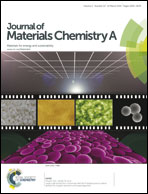Nanowire architectures for iodide free dye-sensitized solar cells†
Abstract
In this study, we show that the performance of iodide free redox couples in dye-sensitized solar cells could be significantly improved by engineering the electron transport and surface properties of the electrode materials. Specifically, tin oxide nanowires electrophoretically coated with titania nanoparticles and subsequently passivated with a submonolayer of alumina by atomic layer deposition show a remarkable ten-fold increase in short-circuit current densities over those obtained with titania nanoparticles, even when a typical N-719 dye is used for sensitization. Comparison of the performance of different electrode materials such as nanowires, nanoparticles and nanowire–nanoparticle hybrid architectures of tin oxide and titania suggests that fast electron transport helps in improving the short-circuit current density with ferrocene/ferrocenium and TEMPO redox couples. The nature of the surface trap states and their passivation have a significant effect on the electron lifetimes in the semiconductor and the resulting open-circuit voltage with these redox couples. The higher electron diffusion lengths with the tin oxide nanowire based architectures allow for thicker electrodes with enhanced dye loading. The analysis of literature data on DSCs made using different dyes and alternate redox couples suggests smaller delta G or reorganization energy for non-ruthenium based dyes.


 Please wait while we load your content...
Please wait while we load your content...